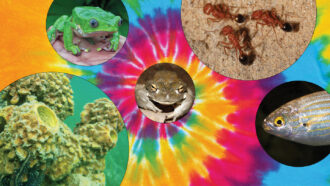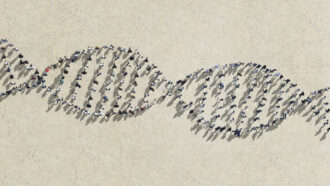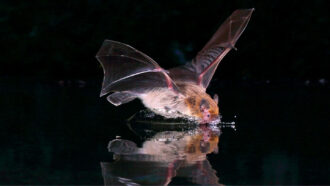Swarming locusts can deploy a chemical to avoid being cannibalized
The “don’t-eat-me” compound signals that the insects have become a toxic treat

For some locusts, like these Locusta migratoria, their fellow insects are on the menu. Juvenile migratory locusts give off a pheromone that stops their companions from cannibalizing them, a new study suggests.
Benjamin Fabian/MPI for Chemical Ecology
For many locusts, life in a swarm is a picnic. Crowded conditions create a locust-eat-locust world. But it turns out some migrating insects deploy a “don’t-eat-me” pheromone that can deter their cannibalistic companions.
When jammed together, juvenile migratory locusts (Locusta migratoria) emit a volatile compound known as phenylacetonitrile, or PAN, researchers report in the May 5 Science. Locusts engineered to not give off the pheromone were eaten more often, the study found. And those unable to detect PAN were more likely to eat others producing it. The results suggest the compound has a role in suppressing cannibalism.
The level of cannibalism in a swarm “will be a constant balance,” says Bill Hansson, a neuroethologist at the Max Planck Institute for Chemical Ecology in Jena, Germany. “How hungry are your friends behind you, and how badly do you smell?”
Cannibalism is pretty common in the animal kingdom. It’s typically a convenient way for animals to supplement their diet when food is scarce. For L. migratoria, the behavior kicks in when the insects switch lifestyles.
As solitary insects, the locusts spend time apart and don’t eat each other. When group density increases — around a dwindling food source, say — locusts go “gregarious” (SN: 8/12/20). They become more attracted to each other and increasingly active, migrating and engaging in cannibalism. That allows groups to survive longer while searching for more nutrients. Some research suggests cannibalism may actually underpin locust swarming behavior, as individuals move en masse to avoid being attacked from the rear.
It was known that L. migratoria produce hundreds of chemical compounds, some of which repel their own species. Hansson and colleagues wanted to see if any of these compounds specifically deterred cannibalistic attacks.
First the team screened for compounds given off only during the gregarious phase. One of these, PAN, piqued the researchers’ interest as it breaks down to form hydrogen cyanide and had previously been shown to repel bird attacks against L. migratoria.
Once the locusts start smelling of the compound, they become a dangerous meal, Hansson says. “The higher the PAN, the more toxic they are.”
Initial experiments showed that locusts produced PAN when things started getting crowded, and the amount increased as more locusts joined the group. Next, the team zeroed in on one gene — LmOR70a — in the locust olfactory system with the strongest response to the chemical compound. Using gene editing, the team created some locusts unable to smell PAN, and others unable to produce it.
Subscribe to Science News
Get great science journalism, from the most trusted source, delivered to your doorstep.
The researchers put groups of locusts into crowded cages of 100 individuals. Rates of cannibalism were less than 5 percent among wild-type locusts, but jumped to around 30 percent among those unable to produce PAN. And when placed in cages with 50 starved yet otherwise normal locusts, non-PAN-producing individuals were attacked and eaten significantly more than locusts smelling of PAN. Locusts engineered to not detect PAN showed no preference for eating those producing the pheromone or those who did not.
Cannibalism is more of a threat to juvenile locusts as they don’t have wings yet, so this compound may be more useful to them. “They have to keep walking and being pushed, so cannibalism becomes a real threat,” Hansson says. “When they are adults, they can fly away.”
The work is “an exciting advancement for locust biology and chemical signaling,” says ecologist Arianne Cease, who heads the Global Locust Initiative at Arizona State University in Tempe. The use of this pheromone explains how highly crowded migratory locusts can gain the benefits of group living without incurring the cost of cannibalism, she says.
L. migratoria is the most widespread species of locust, found across Africa, Eurasia and down to Australia and New Zealand. Plagues have been reported as far back as 200 B.C. in China, and it is currently a major agricultural pest in Russia. Swarms can grow to densities of over 10,000 per square meter.
Blocking locusts’ ability to produce or detect PAN could help control swarms, says Greg Sword, an entomologist at Texas A&M University in College Station. As PAN deters birds too, “blocking the locusts’ ability to produce it should make them simultaneously more vulnerable to both their predators and cannibalistic neighbors,” he says.
“We don’t want to eradicate any species,” Hansson says. “But the cool thing would be if you could diminish the size of the swarms.”







